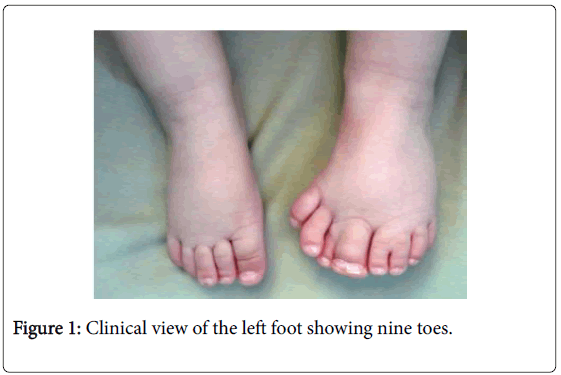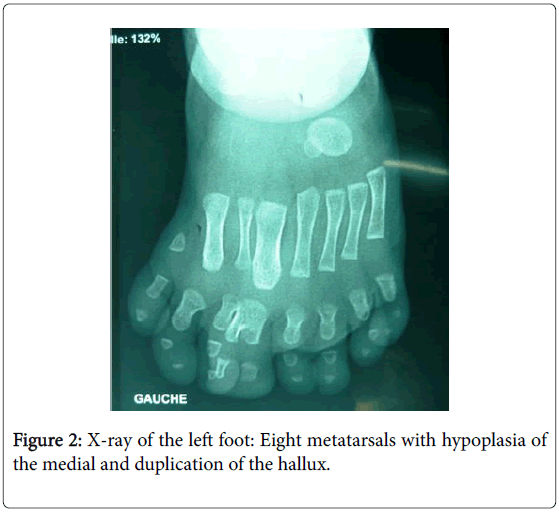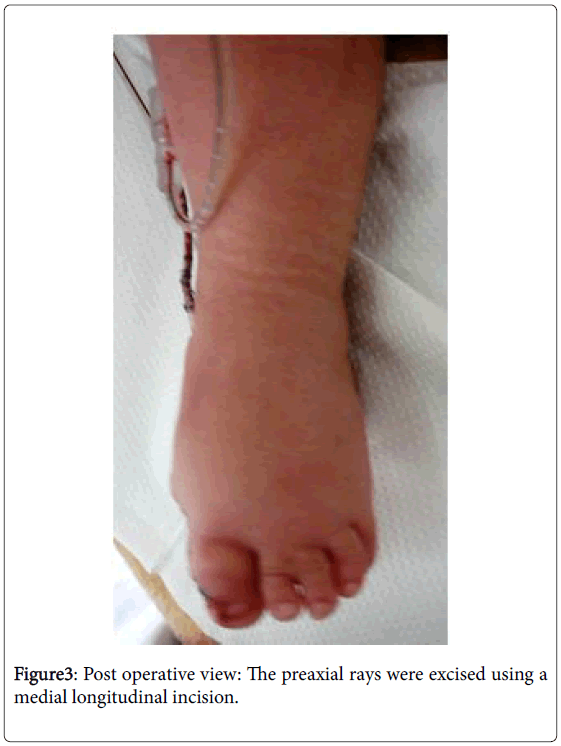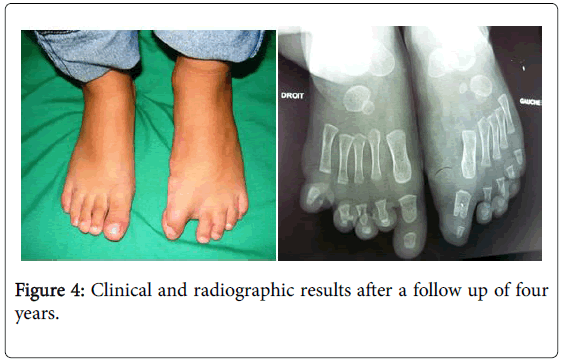A Case Report of a Nine Toes Mirror Foot and Literature Review
Received: 18-Jun-2018 / Accepted Date: 10-Jul-2018 / Published Date: 17-Jul-2018 DOI: 10.4172/2329-910X.1000273
Keywords: Mirror foot; Classification; Surgical treatment
Introduction
Preaxial mirror polydactyly of foot, also called “Mirror Foot” is a rare congenital anomaly. In the literature, we found less than 40 cases reported till now, and only for few cases, the surgical treatment was performed [1-3]. Mirror Foot has a controversial definition: Some called Mirror Foot as “a mirror-image polydactyly”, but the true mirror image was shown only in few cases [3]. Mirror Foot may occur as an isolated deformity [4,5] or as part of a syndrome of multiple congenital abnormalities [1,3]. The functional and cosmetic discomfort of this condition usually requires surgical treatment. We reported an isolated left Mirror Foot surgically treated with a good outcome.
Case Report
A 6-month-old child with preaxial polydactyly of the left foot was referred to our out-patient department. He was born at full term out of a non-consanguineous marriage. Antenatal history was eventful and family history was negative. He was born with macrosomia. No other abnormality was detected.
Clinically, there were nine toes with a duplicated hallux (Figure 1). Tibia, fibula, and ankle were normal. The radiograph showed no supernumerary tarsal bone, there were eight metatarsals with hypoplasic 8th metatarsal and 9 phalanges. Only the phalange of the hallux was duplicated (Figure 2).
Surgical excision and reconstruction was performed under general anesthesia and tourniquet control. The medial three rays were excised by a medial longitudinal approach (Figure 3). Excised accessory tendons were used to reinforce the ligaments of the medial arch.
After a follow up of 4 years, the child was without any discomfort while walking or wearing shoes and the parents are satisfied by the cosmetic result (Figure 4). The X-ray control showed a 15 degree of Hallux varus proposed for correction. Actually, the child’s parents refuse the surgery as long as there is no functional discomfort and the patient is monitored with annual checks.
Discussion
Preaxial Mirror polydactyly is still without strict definition [1,3]. The true definition is author dependent and there is no general classification [3,6,7]. Sudesh, et al. [1] stated that we should differentiate between Mirror foot and polydactyly by the presence of accessory tarsal bone. Watanabe, et al. [8] have added Foot Mirror Duplication to the spectrum of preaxial polydactyly. Belthur, et al. [9] suggested that Mirror Foot is “an extreme form of preaxial polydactyly” and can be considered as an additional type of preaxial polydactyly. Verghese, et al. [10] proposed the term “Preaxial Mirror Polydactyly” which includes feet with supernumerary rays medially situated to the first ray with characteristic of post axial toes. The tarsal duplication was not included due to its variability.
Mirror Foot is an extremely rare condition. According to Fukazawa, et al. review of the English literature [3], only 28 cases of Mirror Feet have been reported until 2009, and the surgical treatment has been for only 7 cases. Tibial and fibular abnormalities, anomalies of hind foot, midfoot and fore foot were variably expressed [6]. The association with mirror hands has also been described with or without syndactyly [2]. Mirror hands have seven or eight digits and no thumb. Mirror Foot is more variable and may have no obvious hallux or a fused central hallux and seven or eight digits [3,11,12]. A literature research revealed only few reports about treatment of Mirror Foot [1]. Mc Carthy, et al. [13] and Galois, et al. [14] described the complexity of the surgical treatment of these abnormalities and stated that the long result had been poor. However, it is less complex than that of its upper limb equivalent due to the difference between hand and foot function [2]. Every case has been treated with an individualized approach but most patients have undergone surgery during childhood, before or after walking age [3,6,13]. According to some authors, surgical treatment should be delayed until ossification for a better anatomic assessment [15].
The usual surgery described is excision of the preaxial rays with an acceptable cosmetic outcome in those cases where only preaxial ray duplication is present without any talar or calcaneal duplication [1]. Karchinov [16] insisted on the excision of supernumerary tarsal bones for a successful treatment of Mirror foot. After 7,5 years gap, Vlahovic, et al. [6] showed the insufficiency of the isolated excision of supernumerary rays of Mirror feet with the supernumerary tarsal bones and the improvement of outcomes after the total excision of the supernumerary bones.
The reconstruction should anticipate hallux varus and persistent widening of the forefoot, as is seen in preaxial polydactyly of the foot, these two anomalies may require further correction, the same for the tibial discrepancy. Despite the good functional and aesthetic outcome, follow up should continue within a multidisciplinary team. Early and regular gait assessment by Physiotherapist and occupational therapist prevent, identify and improve any abnormalities [2].
Conclusion
Mirror Foot is a rare congenital abnormality that may be isolated or in association with multiple congenital anomalies. There is no exact definition due to clinical variability. Adequate and planned surgical treatment improves the functional and the cosmetic outcomes. It consists in reduction of the supernumerary rays and tarsal bones. Follow up is required to detect and treat any further abnormalities on time.
References
- Sudesh P, Kumar V, Jain M, Patel S (2010) Mirror foot and our surgical experience: A case report and literature review. Foot 20: 44-45.
- Mishra A, Nelson K, McArthur P (2010) Mirror foot: A reflection on three cases. J Plast Reconstr Aesthet Surg 63: 2146-2151.
- Fukazawa H, Kawabata H, Matsui Y (2009) Mirror foot: Treatment of three cases and review of the literature. J Child Orthop 3: 277-282.
- Al-Qattan MM, Hashem FK, Al Malaq A (2002) An unusual case of preaxialpolydactyly of the hands and feet: A case report. J Hand Surg Am 27: 498-502.
- Kim KC, Wakui K, Yamagishi A, Ohno T, Sato M, et al. (1997) Tetramelic mirror-image polydactyly and a de novo balanced translocation between 2p23.3 and 14q13. Am J Med Genet 68: 70-73.
- Vlahovic AM, Pistignjat BS, Vlahovic NS (2015) Nine toes: Mirror Foot Deformity. Indian J Orthop 49: 478-481.
- Christensen JC, Leff FB, Lepow GM, Schwartz RI, Colon PA, et al. (1981) Congenital polydactyly and polymetatarsalia: Classification, genetics, and surgical correction. J Foot Surg 20: 151-158.
- Watanabe H, Fujita S, Oka I (1992) Polydactyly of the foot: An analysis of 265 cases and a morphological classification. Plast Reconstr Surg 89: 856-877.
- Belthur MV, Linton JL, Barnes DA (2011) The spectrum of preaxial polydactyly of the foot. J Pediatr Orthop 31: 435-447.
- Verghese R, Shah H, Rebello G, Joseph B (2007) Pre-axial mirror polydactyly associated with tibial deficiency: A study of the patterns of skeletal anomalies of the foot and leg. J Child Orthop 1: 49-54.
- Viljoen DL, Kidson SH (1990) Mirror polydactyly: Pathogenesis based on a morphogen gradient theory. Am J Med Genet 35: 229-235.
- Martin RA, Jones MC, Jones KL (1993) Mirror hands and feet with a distinct nasal defect, an autosomal dominant condition. Am J Med Genet 46: 129-131.
- McCarthy GJ, Lindaman L, Stefan M (1995) Pedal polydactyly: An overview with case report. J Foot Ankle Surg 34: 577-582.
- Galois L, Mainard D, Delagoutte JP (2002) Polydactyly of the foot. Literature review and case presentations. Acta Orthop Belg 68: 376-380.Â
- El-Shazly M (2007) An eight-toed foot: A rare pedal polydactyly. J Foot Ankle Surg 46: 207-209.
- Karchinov K (1973) Congenital diplopodia with hypoplasia or aplasia of the tibia. A report of six cases. J Bone Joint Surg 55: 604-611.
Citation: Hamdi MF, Msek H (2018) A Case Report of a Nine Toes Mirror Foot and Literature Review. Clin Res Foot Ankle 6: 273. DOI: 10.4172/2329-910X.1000273
Copyright: © 2018 Hamdi MF, et al. This is an open-access article distributed under the terms of the Creative Commons Attribution License, which permits unrestricted use, distribution, and reproduction in any medium, provided the original author and source are credited.
Select your language of interest to view the total content in your interested language
Share This Article
Recommended Journals
Open Access Journals
Article Tools
Article Usage
- Total views: 5840
- [From(publication date): 0-2018 - Dec 06, 2025]
- Breakdown by view type
- HTML page views: 4914
- PDF downloads: 926




